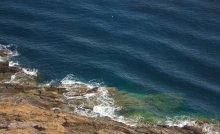There are very few places in Greece without a view of the sea and the sea helped define the Greeks. The land mass of Greece is surrounded on three sides by water, and the two major land masses, Attica and Peloponnesus, also have water between them. The Greek terrain is rocky and mountainous, with limited trees. In fact the joke is that Greece is more suitable for goats than people. Yet, the Greeks have not only survived there and flourished but became the linch-pin for Western Civilization.
With their backs to this rocky and mountainous land, the Greeks faced outward to the sea. The deep blue of the sea fired their imagination and supported their economy. They built trade routes and founded colonies and won a sea victory defeating the Persians and thus saving the future of Western Civilization.
The legend of the 300 hundred Spartans lead by King Leonidas holding off the Persian army of Xerxes at Thermopylae is well known. What is less widely known is the Battle of Salamis, which came shortly thereafter, probably because Hollywood hasn’t made a movie yet. Even as an American-born Greek, traveling to Greece and passing the island of Salamis on the way to my parent’s villages in the Peloponnesus, my uncles, aunts and even cousins would point out that here the Greeks defeated the Persians in the greatest sea battle.
After fighting at Marathon and being aware of the Persian threat to Greece, the Athenian politician, Themistocles persuaded the Athenians to build a fleet of 200 triremes.
Triremes are galley ships with three rows of oars on each side. The triremes were fast and agile. In fact a full-sized replica, Olympias, with an unskilled volunteer crew was able reach a speed of 9 knots and execute 180 degree turns in one minute with an arc no wider than two and a half ship-lengths proving that ancient accounts of the capabilities of these ships was not exaggerated. The Greek ships were outfitted with rams on the bow, resembling an armored beak on the front of a ship used to puncture the hull of an enemy ship.
During the Persian invasion, now general, Themistocles set up a subterfuge to lure the Persian fleet into the Strait of Salamis. The Greek fleet of triremes occupied the strait between the mainland of Greece and the island of Salamis. The Persian ships entered to find a line of Greek ships. Seeming to flee at the advance of the Persian ships, the Greek ships moved back to better position themselves. The Persians sailed further into the strait in pursuit. One of the Greek ships then moved forward and rammed a Persian ship beginning the naval battle. The rest of the Greek ships then sailed towards the Persian fleet and engaged them. The Greek ships formed a wedge and split the Persian line of ships in two. An exact number of Persian ships destroyed is not available but historians believe 300 is a good estimate.
The significance of the battle is that it marked the turning point in the war between the Greeks and Persians. From this point on Greece remained free from invasion by the Persians. Athens flourished and developed philosophy, science, democracy and laid the foundations of Western Civilization. The legacy of Ancient Greece and the Golden Age of Athens became reality by the decisive victory of the Greek fleet at the Battle of Salamis.
And what about those Spartans? Their holding off Xerxes allowed Athens to be evacuated and the fleet under Athenian general Themistocles to assemble at Salamis. Their heroic sacrifice bought the Greeks time and saved Western civilization.
Funny thing is, I wasn’t born in Greece, but I cannot live without being close to the sea. I live in Northern California, in the Bay Area, where from any hilltop in my city, I can look across the Bay, through the Golden Gate and the Pacific beyond. I could never live in a land locked area. In fact I feel claustrophobic if I cannot see open sea. Greek blood does flow through my veins after all.
